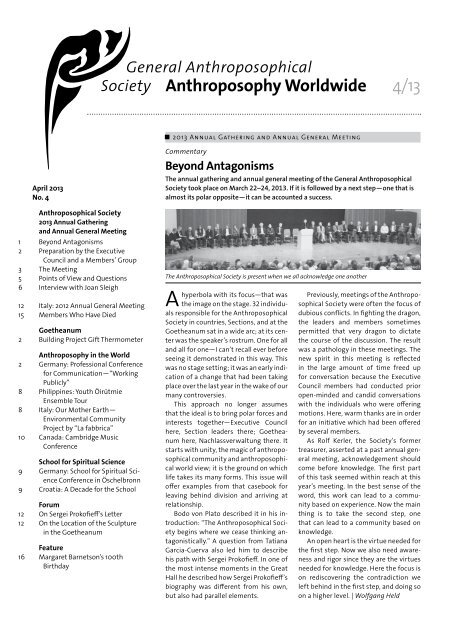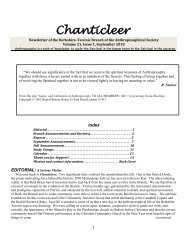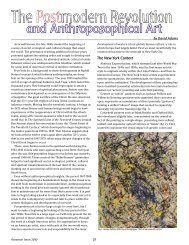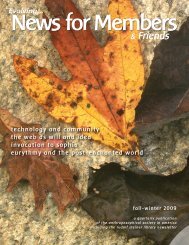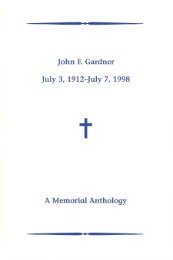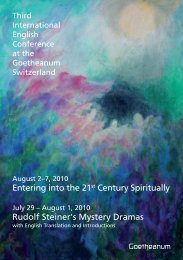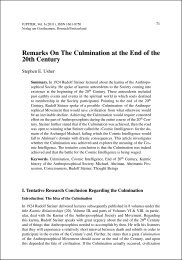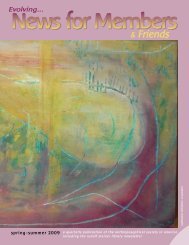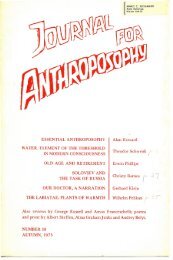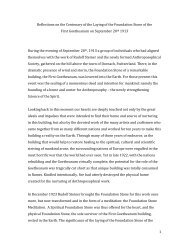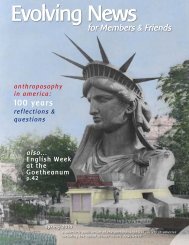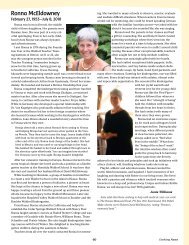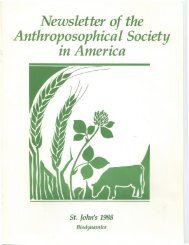Read more in Anthroposophy Worldwide... - Anthroposophical ...
Read more in Anthroposophy Worldwide... - Anthroposophical ...
Read more in Anthroposophy Worldwide... - Anthroposophical ...
You also want an ePaper? Increase the reach of your titles
YUMPU automatically turns print PDFs into web optimized ePapers that Google loves.
2 | <strong>Anthroposophy</strong> <strong>Worldwide</strong> No. 4/13Phase 1Phase 2Phase 3■ GoetheanumGift ThermometerBuild<strong>in</strong>g ProjectAs of March 19, 2013, 5.44 millionSwiss francs have been received forthe Goetheanum Build<strong>in</strong>g Project. Afterreach<strong>in</strong>g our <strong>in</strong>itial goal of 4.5 millionfrancs on January 30, 2012 on schedule,we have entered the second phase of fundrais<strong>in</strong>g.The goal is to reach n<strong>in</strong>e millionfrancs by October 1, 2013.■ <strong>Anthroposophy</strong> <strong>in</strong> the WorldConference Initiative“Work<strong>in</strong>g Publicly”Individuals who are do<strong>in</strong>g public relationswork <strong>in</strong> anthroposophical <strong>in</strong>stitutions andorganizations are often learn<strong>in</strong>g on thejob—<strong>in</strong> this they sometimes feel isolated.The first professional communicationsconference “Work<strong>in</strong>g Publicly” (“öffentlichwirken”) was held for them <strong>in</strong> 2011 with180 attendees. The second conferencewill take place <strong>in</strong> Bochum (Germany) onNovember 1–2, 2013. It is be<strong>in</strong>g organizedby anthroposophical enterprises and theweekly Das Goetheanum.Registration: www.öffentlich-wirken.de■ CorrectionMystery DramaEnsembleThe editor’s <strong>in</strong>troduction on p. 10 <strong>in</strong><strong>Anthroposophy</strong> <strong>Worldwide</strong> No. 3/2013(under the head<strong>in</strong>g “Goetheanum Stage:Mystery Dramas”) listed Gioia Falk andChristian Peter as directors of the full Mysterydrama production and the performancesof <strong>in</strong>dividual scenes. However, thelatter are guided by the “Mysteriendramenhautnah” <strong>in</strong>itiative circle. The designation“Goetheanum Stage” is not meant to <strong>in</strong>dicatethat the Mystery drama ensemble atthe Goetheanum is a permanent ensembleof the Goetheanum stage—this ensembleperforms on the Goetheanum stage, andthe Goetheanum stage is “simply” the hostfor the group. | Sebastian Jüngel■ 2013 Annual Gather<strong>in</strong>g and Annual General Meet<strong>in</strong>gPreparation by the Executive Council and a Members’ GroupMotions, Meet<strong>in</strong>g, Initiatives, <strong>Anthroposophy</strong>This year’s annual gather<strong>in</strong>g and Annual General Meet<strong>in</strong>g owes its name to a cooperativeeffort by a members’ group and the Executive Council. The general focus was onlend<strong>in</strong>g the annual meet<strong>in</strong>g <strong>more</strong> breath<strong>in</strong>g space, chances to meet, a stronger emphasison members’ <strong>in</strong>itiatives, and anthroposophical content.The atmosphere at the Goetheanumbefore an annual meet<strong>in</strong>g is like apreview of the meet<strong>in</strong>g itself. When thereare many motions pend<strong>in</strong>g the mood isstra<strong>in</strong>ed, a sign of dissatisfaction. Thistime I felt the mood was relaxed, quiet.One reason may be that—beg<strong>in</strong>n<strong>in</strong>g <strong>in</strong>fall, 2012—this annual meet<strong>in</strong>g was preparedby the Executive Council work<strong>in</strong>gtogether with a members’ group. Afterthis year’s annual meet<strong>in</strong>g had concluded,Mathias Forster from the members’group told me how the work had begun:“We were received with open arms andcautious open hearts. That changed <strong>in</strong>toa warm, trust<strong>in</strong>g heart quality.”Another reason is found <strong>in</strong> a situationallyappropriate generosity That came tolight, for <strong>in</strong>stance, <strong>in</strong> the fact that therewas no time limit for speakers, and <strong>in</strong>the way motions were handled. DanielMarston wanted to ask that abstentionsbe counted dur<strong>in</strong>g the vot<strong>in</strong>g so that thisform of expression could become visibleas well. Technically speak<strong>in</strong>g, his motionhad arrived too late to be considered, butJustus Wittich drew a connection betweenthe many votes that were taken atthe 2002 annual meet<strong>in</strong>g and a motionadopted at that meet<strong>in</strong>g; accord<strong>in</strong>g to it,votes would be counted only if there wasno clear majority, and abstentions wouldabsolutely not be counted. Wittich said:“Of course it is important whether theentire hall casts a vote, or only a small majorityarrives at the decision. We will makea free decision to count the abstentions.”| Sebastian JüngelDear WMembers of the <strong>Anthroposophical</strong> Societyith these few l<strong>in</strong>es we would like were so complex. These perceptionsto make you aware that a work<strong>in</strong>ggroup (that <strong>in</strong>cludes Executive Council tant questions :have led to the follow<strong>in</strong>g two impor-members Paul Mackay, Justus Wittich and 1. How can we assure that our futureSeija Zimmermann) has been formed with decisions have been prepared conceptuallyso that the various sides ofthe goal of discover<strong>in</strong>g a new form for ourAnnual General Meet<strong>in</strong>gs. The start<strong>in</strong>g the issues are illum<strong>in</strong>ated and a basispo<strong>in</strong>t for this cooperative effort is our for judgment is formed?shared feel<strong>in</strong>g of dissatisfaction with 2. What can we do so that anthroposophythe fact that the consideration of motionshas taken up a significant amount can stand <strong>more</strong> <strong>in</strong> the forefront and beitself (meant to be culturally renew<strong>in</strong>g)of time dur<strong>in</strong>g the Annual General <strong>more</strong> clearly present <strong>in</strong> future meet<strong>in</strong>gs?We consider it necessary to pro-Meet<strong>in</strong>gs, and that concentration onmotions has had a strong impact on the vide a better opportunity for <strong>in</strong>itiativesentire Annual Meet<strong>in</strong>g. Much of what <strong>in</strong> the Society (but also beyond it) to belives with<strong>in</strong> the <strong>Anthroposophical</strong> Society—positive,constructive, and <strong>in</strong>no-constructive contributions .seen, <strong>in</strong>itiatives that make positive andvative elements—is lost from sight and Through this <strong>in</strong>itiative we would like tocannot be developed further. It has also make a contribution to establish<strong>in</strong>g futureAnnual General meet<strong>in</strong>gs that arebeen impossible to consider the very issues,concerns, or new ideas <strong>in</strong>troduced permeated and carried by a mood thatby the motions themselves.is different from the mood of previousyears, and <strong>in</strong> mak<strong>in</strong>g this effort weAnother source of dissatisfaction wasthat it became impossible to f<strong>in</strong>d sufficienttime and space to create a com-support. | The <strong>in</strong>itiative group: Tatia-hope for your understand<strong>in</strong>g and yourmon foundation for mak<strong>in</strong>g a decision; na Garcia-Cuerva, Eva Lohmann-Heck,this was because there were so many Natascha Neisecke, Mathias Forster,motions, and the issues they addressed Thomas Heck, Christopher Schümann
<strong>Anthroposophy</strong> <strong>Worldwide</strong> No. 4/13 | 3The Meet<strong>in</strong>g“Ears Like an Elephant and the Heart of a Giraffe”The Annual General Meet<strong>in</strong>g of the General <strong>Anthroposophical</strong> Society began on March22 <strong>in</strong> an open plenum with the organizers; it closed on March 24 with a performanceof the Foundation Stone meditation <strong>in</strong> eurythmy. Seija Zimmermann was confirmedas an Executive Council member, and Joan Sleigh was added to the Executive Council.Initiative Forum: The 1,000 times 100 boothOne motif of the recent AnnualGeneral Meet<strong>in</strong>g was the assertionthat the <strong>Anthroposophical</strong> Societyis what its members do. As a responseto that—and especially out of the pa<strong>in</strong>of “bump<strong>in</strong>g <strong>in</strong>to the forms” (NataschaNeisecke) and because the life of the soulfelt itself as if “choked” and “devalued”(Mathias Forster)—a group of memberstook the <strong>in</strong>itiative of prepar<strong>in</strong>g almostthe entire meet<strong>in</strong>g together with theGoetheanum Executive Council (p. 2).The Periphery Br<strong>in</strong>gs Strength andHealthOne concern was that the membersbecome visible with their <strong>in</strong>itiatives.That was done with exhibits like those ofthe “Work<strong>in</strong>g Community on a Culture ofDy<strong>in</strong>g” (a subject area branch of the <strong>Anthroposophical</strong>Society <strong>in</strong> Switzerland),the Aerum Artists Association for a guaranteed<strong>in</strong>come, or the young physiciansgroup for its Whitsun meet<strong>in</strong>g—i.e., advancedprojects by members’ groups.Strengthen<strong>in</strong>g the <strong>Anthroposophical</strong>Society is a goal. Rüdiger Krey po<strong>in</strong>ted toseveral possibilities: strengthen<strong>in</strong>g theleadership, ga<strong>in</strong><strong>in</strong>g members, or realiz<strong>in</strong>gthe potential <strong>in</strong> the <strong>Anthroposophical</strong>Society. He and Franziska Bücklershave chosen the latter <strong>in</strong> found<strong>in</strong>g theZweigwerk <strong>in</strong>itiative that organized themeet<strong>in</strong>g <strong>in</strong> Cologne to commemoratethe 100 th anniversary of the <strong>Anthroposophical</strong>Society. Bücklers added: “… it[the <strong>Anthroposophical</strong> Society] doesn’talways just have to grow, grow, grow. Itmust be a healthy organism. Our opportunitylies <strong>in</strong> the fact that we can br<strong>in</strong>gstrength and health from the periphery,that we create a circulation betweencenter and periphery. The members’group around Car<strong>in</strong>a Vaca Zeller (<strong>Anthroposophy</strong><strong>Worldwide</strong>, No. 1-2/2013)also carries this concern.Photo: Sebastian JüngelLaw and CultureAlong with a new visibility, therewas flexibility <strong>in</strong> form. Mathias Forsternoted that an “old form of thought orusage” must pass away “so that the essencecan be freed from the form, so thatpartial forms can arise.” Another memberwished for the courage “to cast thespontaneous element <strong>in</strong>to words,” i.e., tocapture what can be experienced <strong>in</strong> themoment.The Annual General Meet<strong>in</strong>g also hasa connection with civil law. Speakers likeHerbert Holliger and Daniel Marstonpo<strong>in</strong>ted out that the meet<strong>in</strong>g has an (external)basis <strong>in</strong> law, and its rules need tobe observed. “We are,” said Marston, “aspecial sort of association. We often tendto emphasize the special <strong>more</strong> than theassociation.” On the other hand, AlexanderOverhage said that f<strong>in</strong>ances and bylawsshould, of course, be subject to vote,but that otherwise we should attemptto avoid vot<strong>in</strong>g on th<strong>in</strong>gs like whether anew Executive Council member shouldbe accepted. This brought up the topic oftrust and trustworth<strong>in</strong>ess. Paul Mackay<strong>in</strong>vited us “not to understand the Societysimply as an association—also right—but as a culture. A special quality <strong>in</strong> ourSociety is that it is an attempt to createa connection among people, among peoplewho are becom<strong>in</strong>g free.” The task ofthe <strong>Anthroposophical</strong> Society was oftenreflected <strong>in</strong> its connection to the humanbe<strong>in</strong>g: “an attempt to become a humanbe<strong>in</strong>g” (Frode Barkved), the “human be<strong>in</strong>gas an angel <strong>in</strong> tra<strong>in</strong><strong>in</strong>g” (Rob Ste<strong>in</strong>buch),or Jean Michel Flor<strong>in</strong>’s citation ofAnto<strong>in</strong>e de Sa<strong>in</strong>t-Exupéry: “Every humanbe<strong>in</strong>g is a knot <strong>in</strong> a web of connections.”This brought up a further motif from the2012 meet<strong>in</strong>g: the po<strong>in</strong>t is found <strong>in</strong> realhuman connection—it is only connectionthat enables culture.Motions and a Culture of ConnectionIt became clear that contact withpresenters of motions prior to the meet<strong>in</strong>ghelped them feel they had beenheard and their concern was already be<strong>in</strong>gaddressed where possible. MoritzChristoph withdrew his motion on the<strong>Anthroposophical</strong> Society’s approachto money until next year <strong>in</strong> order to seewhether there was real <strong>in</strong>terest <strong>in</strong> thisquestion he considered important (seealso the box on p. 5). Herbert Holligerhad <strong>in</strong>troduced a motion for a <strong>more</strong> exactprovision <strong>in</strong> the bylaws of when andhow the Executive Council was to call anextraord<strong>in</strong>ary general meet<strong>in</strong>g. Based onwhat he and other members felt to bean unsatisfactory approach to the 2012motion on the Society’s responsibility toWeleda, and <strong>in</strong> a new trust toward theExecutive Council after conversationson this issue, Holliger withdrew his motion—hefelt the Executive Council hadissued an appropriate explanation “<strong>in</strong>regard to the m<strong>in</strong>utes.” In that explanationthe Executive Council <strong>in</strong>dicated ithad taken an unsatisfactory formal ap-
4 | <strong>Anthroposophy</strong> <strong>Worldwide</strong> No. 4/13■ 2013 Annual Gather<strong>in</strong>g and Annual General Meet<strong>in</strong>gPhoto: Sebastian JüngelGeneral Secretaries: Demonstration of eurythmy led by Margrethe Solstad (not <strong>in</strong>cluded <strong>in</strong> photo)proach <strong>in</strong> this one <strong>in</strong>stance, although itconsidered the current bylaw provisionadequate.Tatiana Garcia-Cuerva asked aboutthe oppositional relationship betweenBodo von Plato and Sergei Prokofieff. Inhis earlier talk, Bodo von Plato had expla<strong>in</strong>edthat he no longer believed merg<strong>in</strong>gopposite po<strong>in</strong>ts of view should createa whole; <strong>in</strong>stead, he thought that the importantpo<strong>in</strong>t was “how we can f<strong>in</strong>d ourplace as <strong>in</strong>dividuals based on a whole.”Is the Life We Share Enabled?There was a warm and attentivesense of anticipation <strong>in</strong> the hall abouthow Bodo von Plato would answer thisdirect question. Despite his uncerta<strong>in</strong>tyabout the audience’s reaction, he spokefrom the heart. In his Executive Councilwork with Sergei Prokofieff he had alwaysseen someth<strong>in</strong>g “that extendedbeyond the two of us, someth<strong>in</strong>g wecould relate to. I th<strong>in</strong>k the question of ourdifferences is justified only at a certa<strong>in</strong>level.” Of course there were differences<strong>in</strong> their social experiences— <strong>in</strong> SergeiProkofieff’s <strong>in</strong>stance, grow<strong>in</strong>g up <strong>in</strong> atotalitarian state where esoteric workcould only be pursued secretly; and <strong>in</strong>his own case an <strong>in</strong>verse “totalitarianism”where anyth<strong>in</strong>g was possible. Butthere was also someth<strong>in</strong>g <strong>in</strong> commons<strong>in</strong>ce both had grown up <strong>in</strong> surround<strong>in</strong>gswhere conflicts and differences were notdiscussed—“it was part of be<strong>in</strong>g polite.”That prepared the way for the statement:“Perhaps we did not do enoughto br<strong>in</strong>g our different lives together. Butfor me, what we share is greater. I askwhether there is a Society that allows—even demands—that we live the sharedelement and not emphasize opposition.Through what we share <strong>in</strong> our ExecutiveCouncil work I am confident that we canf<strong>in</strong>d someth<strong>in</strong>g <strong>in</strong> common.”Executive Council ChangesThe three changes <strong>in</strong> the ExecutiveCouncil demonstrated further nuances<strong>in</strong> real human connection. In keep<strong>in</strong>gwith a decision made at the 2011 annualmeet<strong>in</strong>g, a seventh-year review of SeijaZimmermann’s work on the ExecutiveCouncil took place. Frode Barkved, GeneralSecretary of the <strong>Anthroposophical</strong>Society <strong>in</strong> Norway, told an anecdote <strong>in</strong>his appraisal. He once got “cold feet” <strong>in</strong>the truest sense of the word; he was notdressed for the weather. Physician SeijaZimmermann had not only seen that hewas cold, but he immediately supplieddry shoes and warm wool socks. In a secretwritten ballot she was confirmed foranother seven years with 334 <strong>in</strong> favor, 33opposed, 28 abstentions, and one <strong>in</strong>validballot.Virg<strong>in</strong>ia Sease described how JoanSleigh was recommended for the ExecutiveCouncil based on professionaland personal encounters. She unitestwo streams: the Camphill communitythrough her mother, a daughter of KarlKönig; and the Christian Communitythrough her father who is a ChristianCommunity priest. Joan Sleigh provideda humorous moment <strong>in</strong> the meet<strong>in</strong>gwhen she spoke about elephants and giraffesat the end of her comments. Theelephant (“a wonderful animal”) has bigears and a good memory—it can listenwell. Giraffes have the largest heart ofall mammals. “I would like to br<strong>in</strong>g thatalong—elephant ears and a giraffe’sheart.” A large majority at the meet<strong>in</strong>gvoted to add Joan Sleigh to the ExecutiveCouncil (with two no votes and sixabstentions.Honor<strong>in</strong>g Sergei ProkofieffSergei Prokofieff had left the ExecutiveCouncil for reasons of health, althoughhe feels that he stands <strong>in</strong> the stream ofcont<strong>in</strong>uity represented by the ExecutiveCouncil. Virg<strong>in</strong>ia Sease also had the taskof thank<strong>in</strong>g him while honor<strong>in</strong>g his wishto keep it simple. She noted that SergeiProkofieff and his books are appreciatedaround the world. His study and researchput him <strong>in</strong> a position to become an <strong>in</strong>terpreterof Rudolf Ste<strong>in</strong>er, one who recognizesthe element that sh<strong>in</strong>es throughRudolf Ste<strong>in</strong>er’s work. As <strong>in</strong>terpreter,Sergei Prokofieff was able to “presentus with images” of the archetypal picturesfound <strong>in</strong> the sphere where RudolfSte<strong>in</strong>er stood. Virg<strong>in</strong>ia Sease closed witha request. If we imag<strong>in</strong>e look<strong>in</strong>g at SergeiProkofieff’s work <strong>in</strong> ten, twenty, thirtyyears, we see two tasks: To do <strong>more</strong> anthroposophy,and “not to wrap him <strong>in</strong> acloud of enthusiasm…for too much enthusiasmh<strong>in</strong>ders a person <strong>in</strong> what theycan do.”In the open plenum prior to the meet<strong>in</strong>gCar<strong>in</strong>a Vaca Zeller had asked that thetheme for the year not be so tailored to
6 | <strong>Anthroposophy</strong> <strong>Worldwide</strong> No. 4/13■ <strong>Anthroposophical</strong> SocietyGeneral <strong>Anthroposophical</strong> Society: New Executive Council member Joan Sleigh“In every situation new decisions must be made”On March 23, the Annual General Meet<strong>in</strong>g approved Joan Sleigh as a member of theGeneral <strong>Anthroposophical</strong> Society’s Executive Council. She has experience <strong>in</strong> South Africaand Germany, and as a Waldorf teacher. In her, the Executive Council will—for thefirst time—have a representative of the Southern Hemisphere and of motherhood.In 1962 Joan Sleigh was born <strong>in</strong> SouthAfrica where she lived <strong>in</strong> Camphill andattended the Waldorf School <strong>in</strong> CapeTown for a time. At the age of 20 she marriedand moved to Germany. There shestarted a family and studied to be a Waldorfteacher at the Institute for WaldorfEducation <strong>in</strong> Witten/Annen. Thirteenyears later she returned with her childrento South Africa. S<strong>in</strong>ce then she hasbeen active as a Waldorf teacher, and forthe past six years she has also been an <strong>in</strong>structor<strong>in</strong> the teacher tra<strong>in</strong><strong>in</strong>g sem<strong>in</strong>ar.Sebastian Jüngel: How were you askedabout jo<strong>in</strong><strong>in</strong>g the Executive Council?Joan Sleigh: It was completely unexpected.I was “shocked” because I sawmy task as be<strong>in</strong>g <strong>in</strong> South Africa. It wasa while before I could even th<strong>in</strong>k aboutwhat it would mean to work on the ExecutiveCouncil. I looked back on my lifeand concluded that I would accept thechallenge. I have been guided and supportedmany times dur<strong>in</strong>g my life, and Ihave the feel<strong>in</strong>g that I might now have achance to give someth<strong>in</strong>g back.Jüngel: How might we imag<strong>in</strong>e the situation?Did the phone r<strong>in</strong>g?Sleigh: I returned to South Africa fromBochum and found a message on my answer<strong>in</strong>gmach<strong>in</strong>e. In the telephone conversationthat followed Virg<strong>in</strong>ia Seaseasked me whether I could imag<strong>in</strong>e accept<strong>in</strong>gthis task.Africa and EuropeJüngel: Africa and Europe are <strong>in</strong> the sametime zone—does this mean they havesometh<strong>in</strong>g <strong>in</strong> common.Sleigh: The two cont<strong>in</strong>ents are very different.But their differences complementone another and form a whole. I have theimpression that every European ought tocome to Africa, and every African shouldbe <strong>in</strong> Europe at some po<strong>in</strong>t.Jüngel: What does Africa mean to you?Sleigh: To me, my life <strong>in</strong> South Africa wasan important preparation for the task atthe Goetheanum. South Africa has speciallife forces: everyth<strong>in</strong>g is <strong>more</strong> openand immediate, experiences are <strong>more</strong><strong>in</strong>tense and <strong>in</strong>timate, and the human elementcan be experienced <strong>more</strong> directly.One lives much closer to the threshold,and there is a need to be awake and present.The daily pa<strong>in</strong> and the daily beautycontribute to a capacity to f<strong>in</strong>d <strong>in</strong> thedepths of my soul the power needed totake up this new task. I am <strong>in</strong>terested tosee how I will get along with the “veiled”sun <strong>in</strong> Europe s<strong>in</strong>ce I am a bit “sun-hungry.”Perhaps it will be possible to carry asun with<strong>in</strong> myself.Jüngel: And your connection to Europe?Sleigh: Life forces and soul experiencescan be deepened <strong>in</strong> Europe. In Germany Ilearned to deepen my be<strong>in</strong>g and be <strong>more</strong>thorough. I hope I can br<strong>in</strong>g a measure oflife force and enthusiasm to the Goetheanum.Perhaps I will have to go back toSouth Africa now and then to refill mytank with life force and “craz<strong>in</strong>ess.”Jüngel: Are Africa and Europe specialplaces for you, perhaps places wherecerta<strong>in</strong> karmic tasks can be worked out?Sleigh: I don’t see any differences there<strong>in</strong> regard to karmic questions. To besure, we are born or “brought” to placeswhere we have karmic tasks. But the basicneeds of children are the same globally,for example. Of course, poverty andviolence <strong>in</strong> Africa produce needs that aredifferent from Europe. The needs <strong>in</strong> Europeare <strong>more</strong> on the level of the soul,while people <strong>in</strong> Africa are <strong>more</strong> stronglychallenged <strong>in</strong> an outer, existential way.Jüngel: What do you th<strong>in</strong>k about globalization?Sleigh: I f<strong>in</strong>d it important, but also dangerous.It is important to be “<strong>in</strong>clusive,”to look beyond the edge of one’s plateand be conscious of all mank<strong>in</strong>d. At thesame time, it becomes <strong>more</strong> importantto be <strong>in</strong>dividually responsible, even downto the smallest decisions and actions.In Africa I learned that we must be awaketoday—we can no longer sleep. Everyth<strong>in</strong>gis chang<strong>in</strong>g and mov<strong>in</strong>g; <strong>in</strong> everysituation new decisions must be made;Liv<strong>in</strong>g anthroposophy: Joan Sleighthere are no recipes. I am glad we live at acritical time, glad we are challenged andasked to be flexible and present!Center and Periphery—A Po<strong>in</strong>t at Rest and Little FlamesJüngel: What does the <strong>Anthroposophical</strong>Society mean to you?Sleigh: The Society at the Goetheanumis the heart for me, the hearth, the homefor the be<strong>in</strong>g Anthroposophia that canstream out actively and liv<strong>in</strong>gly <strong>in</strong>to theworld, and work there. There is a space,a meet<strong>in</strong>g po<strong>in</strong>t, at the Goetheanumwhere everyth<strong>in</strong>g can connect and becomefruitful so that it can work activelyand with new power at the periphery.Jüngel: And what does the <strong>Anthroposophical</strong>Society <strong>in</strong> Germany or <strong>in</strong> SouthAfrica mean to you?Sleigh: It lives <strong>in</strong> the periphery like littleflames, separated from the hearth.These flames are very important foreach country, and they need a connectionto the center. In South Africa, for <strong>in</strong>stance,there is a feel<strong>in</strong>g of be<strong>in</strong>g alone<strong>in</strong> the battle. There we are all fightersfor Michael, but we need a connectionto one another—and that goes throughthe Goetheanum. A colleague once saidto me: We need an active life at the peripheryand a po<strong>in</strong>t at rest <strong>in</strong> the center, ahearth which would make that life at theperiphery possible.
<strong>Anthroposophy</strong> <strong>Worldwide</strong> No. 4/13 | 7Photo: Sebastian JüngelJüngel: But why is the <strong>Anthroposophical</strong>Society necessary if there are well-established<strong>in</strong>stitutions and active anthroposophicalwork <strong>in</strong> many places?Sleigh: Activity occurs <strong>in</strong> the limbs but isfed from the heart, the center. Peripheryand center need one another. The basicimpulse is cultivated and people canmeet at the center. On the periphery,people are active <strong>in</strong> applied fields. Activityrequires a po<strong>in</strong>t at rest for reflection.That is the center’s task. When consciousnessis held <strong>in</strong> stillness, energy canflow to the periphery; the pulse <strong>in</strong> theperiphery f<strong>in</strong>ds its source <strong>in</strong> the heart.Jüngel: What is your vision of the <strong>Anthroposophical</strong>Society?Sleigh: I am <strong>in</strong>terested <strong>in</strong> human encounter.By that I mean the follow<strong>in</strong>g: Thepo<strong>in</strong>t <strong>in</strong> a human encounter is to makeroom for the other so that the other—theentire be<strong>in</strong>g of the other—can be seen,heard, and experienced rightly. In theprocess we learn to know ourselves. Seen<strong>in</strong> this way, human encounter is a giv<strong>in</strong>gand receiv<strong>in</strong>g, an awaken<strong>in</strong>g <strong>in</strong> ourselvesand also an awaken<strong>in</strong>g with<strong>in</strong> the other.In this process I wish to address the humanbe<strong>in</strong>g, member or not—to see thathuman be<strong>in</strong>g <strong>in</strong> his or her pure humanity.To do so I would like to meet peoplefrom every field of life, from every po<strong>in</strong>tof view, and from every cultural group.That also means I want to accomplish mywork by liv<strong>in</strong>g anthroposophy. Of course,we must also study and discuss it. To me,be<strong>in</strong>g a representative means opennessto all people, and also a deep <strong>in</strong>ner connectionto Anthroposophia.A Stronger I—In Ourselves and OthersJüngel: What are your spiritual <strong>in</strong>terests?Sleigh: I am concerned with everyth<strong>in</strong>gconnected with the social realm, andparticularly with the nature of the I. Thequestion of leadership is an importantpart of this: personal leadership, leadership<strong>in</strong> a community, or the leadership ofall mank<strong>in</strong>d. But do we need “leaders” atall? Every leader needs others who follow.Who wants to follow today? How dowe become “leaders” <strong>in</strong> ourselves? Thatbr<strong>in</strong>gs us to the question: Where is thepower of the I? How do we strengthenthe I <strong>in</strong> ourselves and recognize—acknowledge—it<strong>in</strong> other people? How dowe make it possible for other human be<strong>in</strong>gsto grasp their dest<strong>in</strong>y?Jüngel: You have already emphasizedyour <strong>in</strong>terest <strong>in</strong> human encounter. Justhow does this occur?Sleigh: In the I and <strong>in</strong> the other, <strong>in</strong> the Iand with you.Jüngel: How does that look with the peopleof today?Sleigh: Children are much <strong>more</strong> <strong>in</strong>dividualistic,<strong>more</strong> <strong>in</strong> touch with themselves,<strong>more</strong> awake than when I was a child.They feel they can do anyth<strong>in</strong>g. They alsof<strong>in</strong>d it <strong>more</strong> difficult to be comfortable<strong>in</strong> the social sphere, <strong>in</strong> what happensbetween people. They need much <strong>more</strong>understand<strong>in</strong>g and recognition from us,and guidance through liv<strong>in</strong>g examples.The po<strong>in</strong>t is to make it possible for themto develop their own unique nature andstill feel at home <strong>in</strong> a group. That we allhave to do so <strong>in</strong> our own lives can only belearned through practice.Human Development <strong>in</strong> EncounterJüngel: How do the people <strong>in</strong> South Africaview anthroposophy?Sleigh: There is great openness and <strong>in</strong>terest<strong>in</strong> anthroposophy. For <strong>in</strong>stance, Waldorfeducation is “blossom<strong>in</strong>g” amongparents and pupils <strong>in</strong> the schools, <strong>in</strong> theteacher tra<strong>in</strong><strong>in</strong>g courses, and <strong>in</strong> the societyat large. To be sure, there are not somany people who become members ofthe <strong>Anthroposophical</strong> Society or adoptanthroposophy as a way of liv<strong>in</strong>g. Thepo<strong>in</strong>t is that anthroposophy is then appliedas way of life, and not simply asa beneficial method. That decisive stepoften comes out of a personal encounter.Then it becomes possible to makeeach other aware of someth<strong>in</strong>g spiritual,someth<strong>in</strong>g deeper/higher—for developmentof the human soul does not takeplace through study; it takes place <strong>in</strong> humanencounter.Dur<strong>in</strong>g a co-worker’s meet<strong>in</strong>g at theGoetheanum, Joan Sleigh answereda question about whether she knowswhat lies ahead: “The first th<strong>in</strong>g is to supportVirg<strong>in</strong>ia Sease <strong>in</strong> the English Studiesprogram. I also have a sense that this isa large task and responsibility, and I willdo my best with it. I am not com<strong>in</strong>g withflags fly<strong>in</strong>g, with some agenda. I want tokeep my ears open and get a feel<strong>in</strong>g forwhat is happen<strong>in</strong>g here. I want to placemyself and my best efforts <strong>in</strong> the serviceto the life of the Goetheanum. ■Das GoetheanumThe German-LanguageWeeklyWide SpectrumTimely Themes<strong>Anthroposophical</strong> AuthorsGoetheanum NewsI would like to subscribe toDas GoetheanumOne year € 98Name . . . . . . . . . . . . . . . . . . . . . . . . . . .Address (Includ<strong>in</strong>g postal code). . . . . . . . . . . . . . . . . . . . . . . . . . . . . . . . . .. . . . . . . . . . . . . . . . . . . . . . . . . . . . . . . . . .. . . . . . . . . . . . . . . . . . . . . . . . . . . . . . . . . .Country . . . . . . . . . . . . . . . . . . . . . . . . .Date . . . . . . . . . . . . . . . . . . . . . . . . . . . . .Signature . . . . . . . . . . . . . . . . . . . . . . .Please send to:Wochenschrift Das GoetheanumPostfach, CH– 4143 Dornach,SwitzerlandFax +41 61 706 44 65www.dasgoetheanum.ch
8 | <strong>Anthroposophy</strong> <strong>Worldwide</strong> No. 4/13■ <strong>Anthroposophy</strong> <strong>in</strong> the WorldPhoto: SuppliedTour <strong>in</strong> the Philipp<strong>in</strong>es: The audience was enthusiasticEvil spirits: Young people rehearse before the DolomitesPhilipp<strong>in</strong>es: Tour by theYouth Öirütmie EnsembleEurythmy witha Government OfficeFor three weeks <strong>in</strong> October 2012 theYouth Öirütmie Ensemble toured thePhilipp<strong>in</strong>es. 6,000 people attendedthe Eurythmy performances. The Ensembleconsists of n<strong>in</strong>e young people,the leader Tanja Baumgartner, and tourmanager Eckart Grundmann.Red and green—that is Benjam<strong>in</strong>’sanswer to the question of Asia’s colors.When you can turn your gaze awayfrom the enormous, sprawl<strong>in</strong>g cities <strong>in</strong>Asia, the saturated green that radiates<strong>in</strong>to the eye fades <strong>in</strong>to a somewhat <strong>in</strong>dist<strong>in</strong>ctreddish shimmer that lies likea veil over the horizon; it disappears asfast as it came. This is not the golden,susta<strong>in</strong>ed radiance of the sun we Europeansknow from the palm groves <strong>in</strong> theMediterranean area.Bumpy Roads through P<strong>in</strong>eapple FieldsOne of the most impressive and memorableexperiences for all of us was thereception by the governor of Cotabato,a prov<strong>in</strong>ce with 18 communities on theisland of M<strong>in</strong>danao. The person whomet us was not a stern old gentlemanbut rather an open, warm-hearted (andexhausted) woman. It was a very touch<strong>in</strong>gexperience to do eurythmy for her, tohelp her ease her tensions, to have an entiregovernment office do the Hallelujah,and to see how open these people wereto someth<strong>in</strong>g that was still completelyunfamiliar to them.This sort of Filip<strong>in</strong>o openness wasalso an element that allowed our performancesto become moments <strong>in</strong> whichnew movements and experiences couldarise aga<strong>in</strong> and aga<strong>in</strong>—where a tangopiece could suddenly and without priorplann<strong>in</strong>g be expanded <strong>in</strong>to a movementof separation and reunion; or where empathyfor the same piece could <strong>in</strong>stantlyfill 3,000 people <strong>in</strong> a basketball arenawith enthusiasm.Banal th<strong>in</strong>gs like our trip together <strong>in</strong>an open pickup truck over the bumpyroads through p<strong>in</strong>eapple fields led us<strong>in</strong>to a situation where we got to knowone another through psychological partygames. Even our simple “acceptance”of up to six meals <strong>in</strong> a day—so we wouldavoid disappo<strong>in</strong>t<strong>in</strong>g the <strong>in</strong>credible hospitalityof the Filip<strong>in</strong>os—forged us <strong>in</strong>toa group that shared experiences with a“we” dynamic, and showed us what ispossible when <strong>in</strong>dividuals work together.Be<strong>in</strong>g AwakenedOf course, th<strong>in</strong>gs were not alwayseasy. At the outset—when we still neededrehearsals to make our program readyfor the stage—it was not always easyto forget our own needs and give ourgroup and our project the absolute prioritythey demanded. We tried to “wakeup” the others, and be “awakened” ourselveswhen we were still dream<strong>in</strong>g,but not aware of it. As our leader, TanjaBaumgartner said, we want to br<strong>in</strong>g ourshared child <strong>in</strong>to the world; only thencan we turn to address<strong>in</strong>g our secondaryand very personal affairs.And I believe we might say: We did it!We brought a child to the Philipp<strong>in</strong>es—and although it still wears baby shoes, ithas taken its very first steps, supported<strong>in</strong> the process by countless hands; it hasbeen seen and valued by so many eyes.| Mayra Bosshard (Switzerland)www.jugend-eurythmie.chItaly: Community Ecology Project OurMother Earth by La fabbricaEurythmy with YoungPeople and AdultsGia van den Akker has founded a eurythmystudio (La fab brica ) <strong>in</strong> the smallvillage of Cortiglione <strong>in</strong> Piedmont wheresummer courses, cont<strong>in</strong>u<strong>in</strong>g tra<strong>in</strong><strong>in</strong>g,presentations and meet<strong>in</strong>gs take place.Now the youth community eurythmyproject Our Mother Earth is be<strong>in</strong>g prepared.In Cortiglione I was viewed with alittle caution at first, with a certa<strong>in</strong>suspicion. But the village residents soonwarmed up to La fabbrica. S<strong>in</strong>ce then wehave been <strong>in</strong>vited to help with villagefestivals.I am currently prepar<strong>in</strong>g a project thatbr<strong>in</strong>gs young people and adults, artistsand lay people together <strong>in</strong> a socialeurythmysculpture. This project arisesfrom various sources. I received a bookas a gift before Christmas, 2011. The author,Klaas van Egmond, is a scientist andwas a susta<strong>in</strong>ability advisor to the governmentof the Netherlands. He presentsthe topic of susta<strong>in</strong>ability <strong>in</strong> a newway—with a background and an outlookfor development.“Rhythm is it” and “Kotura” as ModelsDur<strong>in</strong>g the twelve Holy Nights Iawoke from a dream determ<strong>in</strong>ed to dosometh<strong>in</strong>g for nature. Earlier, I had readAbol<strong>in</strong>a, a fairy tale from the Dolomitemounta<strong>in</strong>s. It is the tale of a noble maidenwho falls ill. A woman from the forestrecommends that she gaze at the dawn.This heals the girl. Then the woman tellsthe maiden to give the light back s<strong>in</strong>cethe nature spirits would have to suffer
<strong>Anthroposophy</strong> <strong>Worldwide</strong> No. 4/13 | 9■ School for Spiritual SciencePhoto: Gia van den Akkerif she did not. But she fails to do so. Thegirl is abducted by the nature spirits andturned <strong>in</strong>to a stone—until she gives thelight back to others. Later, when a soldierloses his way and calls for help, the girlgives him light to illum<strong>in</strong>ate his path backto the valley.I was deeply <strong>in</strong>spired by the “Rhythmis it” project <strong>in</strong> Berl<strong>in</strong>, and “Kotura” at theGoetheanum. All these th<strong>in</strong>gs mergedwith my <strong>in</strong>tention of creat<strong>in</strong>g a socialcontext <strong>in</strong>stead of simply offer<strong>in</strong>g eurythmy—perform<strong>in</strong>git, and then go<strong>in</strong>g alongon my way.Social ActionI had met Bett<strong>in</strong>a Knop and Roberto SebastianoRossi, leaders of an open youthgroup, at the Forum Festival 2 <strong>in</strong> Witten/Annen. In them I discovered two partners.There will be a conference <strong>in</strong> Tur<strong>in</strong> and Milanentitled “La nostra madre terra” (OurMother Earth); it will offer artistic coursesand a roundtable discussion on susta<strong>in</strong>abilityand agriculture. After a meal oforganic foods, the day will close with theeurythmy performance of Abol<strong>in</strong>a.We eurythmists are prepar<strong>in</strong>g the fairytale together with an actor and musicians,and with music by the Milanese composerSimone Fontanelli. The group choreographywill be done by students from theWaldorf schools <strong>in</strong> Tur<strong>in</strong> and Milan, andan open youth group <strong>in</strong> Trento. Costumedesigner Katja Nestle sent us the patternsfrom Berl<strong>in</strong>; the groups will sew their owncostumes. This means that the teachers,parents, and students at the two schoolswill work together.Of course, beyond the actual productionthe project entails expenses for organizationand travel costs. At the beg<strong>in</strong>n<strong>in</strong>gI thought that the budget would beimpossible to manage. Fortunately, the<strong>Anthroposophical</strong> Societies <strong>in</strong> Italy, theNetherlands, and Switzerland will supportus with a significant grant for the productionof Abol<strong>in</strong>a at the Rudolf Ste<strong>in</strong>er exhibition<strong>in</strong> Rovereto. | Gia van den Akker,Cortiglione (Italy)Production: La nostra madre terra/Albol<strong>in</strong>a:– May 5: Tur<strong>in</strong> (Grugliasco)– Fall: Milan (October 19–20) and Colle (Datestill open)Performance Albol<strong>in</strong>a:May 10 8:30 pm, at the Rudolf Ste<strong>in</strong>er Exhibit<strong>in</strong> RoveretoInfo: www.giavandenakker.comGermany: School for Spiritual ScienceConference <strong>in</strong> ÖschelbronnQuality and ContactS<strong>in</strong>ce 2010, annual School for SpiritualScience conferences have been held at JohannesHouse <strong>in</strong> Öschelbronn. This givesresidents a chance to take part <strong>in</strong> a highqualitymeet<strong>in</strong>g, and meet and discusswith many participants who come fromelsewhere.Of the c. 300 residents at JohannesHouse, 50 are members of the FirstClass of the School for Spiritual Science.On the first even<strong>in</strong>g there is a public lecture,while the second day brought threeblocks of time with freely held Class lessons,and <strong>in</strong> between there are two periodsof eurythmy. There was anotherfreely held Class lesson on the third day,followed by eurythmy and a conversationwith the entire group at the close ofthe meet<strong>in</strong>g.A Passage through the Mantra GroupsFrom the po<strong>in</strong>t of view of content, ourplan<strong>in</strong>g for the last several years has followedthe <strong>in</strong>ner structure of the Class lessons.We began <strong>in</strong> 2010 with lessons oneto seven, the “Path of exercises lead<strong>in</strong>g thehuman be<strong>in</strong>g to the threshold.” Serge Prokofieff,Hans Broder von Laue, WolfgangDrescher and Johannes Ziemann held thelessons. In 2011 Bodo von Plato took part;Jean-Sébastien Catalan and von Laue alsoheld lessons seven to eleven, the “Pathof exercises on this side and the otherside of the threshold.” In 2012 Seija Zimmermann,von Laue, and Drescher heldthe lessons: the “Path of exercises on thisside and the other side of the threshold:the third step on the path through the 19lessons—lessons eleven to sixteen.”We plan to work with Paul Mackay onlessons seventeen to n<strong>in</strong>eteen: the “Pathof exercises on this side and the otherside of the threshold—the human be<strong>in</strong>g<strong>in</strong> the realm of the cosmic midnight.” Thedates are October 11–13, 2013.The eurythmy offered each year byElke Elisabeth von Laue deserves specialmention. It is challeng<strong>in</strong>g to work on variousexperiences of eurythmy with sucha mixed group of people. The work <strong>in</strong>Öschelbronn consists of small, manageableelements. | Uli Molsen, Bal<strong>in</strong>gen(Germany)CroatiaA Decade for the SchoolKnow<strong>in</strong>g One AnotherOn November 24, 2012, twelve Classmembers gathered at the Marija SofijaBranch <strong>in</strong> Zagreb. They met to look backat the work of the First Class of theSchool for Spiritual Science that has beentak<strong>in</strong>g place <strong>in</strong> Croatia for the past tenyears, and consider its importance.Almost all those present had alsobeen there at the “<strong>in</strong>carnation”of the School for Spiritual Science, theMichael School, <strong>in</strong> a new country and anew language. The event also attractedpeople from neighbor<strong>in</strong>g countries, andcont<strong>in</strong>ues to do so today. Unfortunately,Rudolf Moebius from Bad Boll, Germany—ourloyal helper and colleague <strong>in</strong> thefound<strong>in</strong>g of the First Class here—was unableto attend because of health.The meet<strong>in</strong>g began with eurythmy<strong>in</strong> a circle. This was followed by an <strong>in</strong>timateexchange on the question: Whatdoes it mean to me that I am a member<strong>in</strong> the Michael School? This allowed usto experience all our friends <strong>in</strong>wardly.The exchange was marked by different<strong>in</strong>dividual experiences—we got to knoweach other better! Then we once aga<strong>in</strong>immersed ourselves <strong>in</strong> movement: Underthe direction of eurythmist EnitaNurkiće we brought a poem by a Bosnianpoet to life.Spurred to Consciousness and ActionWe prepared the third Class lessonfor the meet<strong>in</strong>g; on the next day <strong>in</strong> wasapproached <strong>in</strong> the way practiced oncea month <strong>in</strong> Zagreb. We spoke of our experiencesas we worked with the secondClass lesson, and thus we created abridge to the third.You could sense how be<strong>in</strong>g together<strong>in</strong> conversation, action, and eat<strong>in</strong>g gaverise to a mood <strong>in</strong> which each of us wasspurred to new consciousness and action,and a call for “<strong>more</strong> anthroposophy”could be experienced.The meet<strong>in</strong>g culm<strong>in</strong>ated beautifullywith a report by Alen Guca (oneof our two Classholders) on the secondchapter <strong>in</strong> Sergei Prokofieff’s book TheFirst Class of the Michael School and itsChristological Foundations. | MladenMaljkovic,,Oprtalj (Croatia)
10 | <strong>Anthroposophy</strong> <strong>Worldwide</strong> No. 4/13■ <strong>Anthroposophy</strong> <strong>in</strong> the WorldCanada: On the Tenth Anniversary of Cather<strong>in</strong>e Carmack’s Death (1957–2003)Cambridge Music ConferenceN<strong>in</strong>e music conferences <strong>in</strong> twelve years—these are only the outer statistics for theCambridge Music Conference. Elizabeth Carmack brought the conference from Brita<strong>in</strong>to Canada where it found a strong supporter <strong>in</strong> Philip Thatcher. The impetus for theconferences was the death of Carmack’s sister Cather<strong>in</strong>e ten years ago.Sebastian Jüngel: What motivated youfor the Cambridge Music Conference?Elizabeth Carmack: The <strong>in</strong>spiration wasmy sister Cather<strong>in</strong>e Carmack who diedafter a seven-year battle with breastcancer. My sister was a professional cellistwho researched the relationship betweenmusic and heal<strong>in</strong>g and wrote aMaster’s thesis at Cambridge Universityon the neurological development of thebra<strong>in</strong>. The Cambridge Music Conferencewas my attempt to celebrate the valuesat the heart of my sister‘s career.Although meant as a one-time event,the conference took a successful life ofits own <strong>in</strong> 2001. For <strong>in</strong>stance, the BBCWorld Service covered the 2001 conferenceand that resulted <strong>in</strong> the ideas be<strong>in</strong>gacknowledged <strong>in</strong>ternationally.Connection with the Grail ThemeJüngel: You now live <strong>in</strong> Canada, the newhome for the Conference. Why?Carmack: When I moved to Canada <strong>in</strong>2008, I was not sure about transplant<strong>in</strong>gthe ideas of the Conference. But I carriedthe hope that I might be able to br<strong>in</strong>g theimpulse back to its home. Cather<strong>in</strong>e hadlived for many years <strong>in</strong> North Vancouver,where she had her music studio, and—<strong>more</strong> importantly — had been active<strong>in</strong> the <strong>Anthroposophical</strong> Society withconcerts and festivals. Shortly after myarrival I asked Philip Thatcher, then GeneralSecretary of the <strong>Anthroposophical</strong>Society <strong>in</strong> Canada, if he might be <strong>in</strong>terested<strong>in</strong> help<strong>in</strong>g. Philip‘s lifelong studyof Wolfram von Eschenbach‘s Parzivalbecame the focus of the first conference<strong>in</strong> Canada as we forged the new theme,Parzival‘s Grail Quest <strong>in</strong> Our Time.In 2010 the Greater Vancouver TherapeuticalSociety for <strong>Anthroposophical</strong>Medic<strong>in</strong>e had decided to take a breakfrom their annual autumn conferenceand. As a result they welcomed the Parzivalconference.Jüngel: Philip, what were your reasonsfor welcom<strong>in</strong>g the Cambridge MusicConference to Vancouver?Philip Thatcher: My connection withCather<strong>in</strong>e and respect for Elizabeth‘scourage <strong>in</strong> br<strong>in</strong>g<strong>in</strong>g this impulse to Vancouverwithout the support network shehad cultivated <strong>in</strong> England. The chance toexplore Wolfram von Eschenbach’s tell<strong>in</strong>gof Parzival from another perspectivedeepened my <strong>in</strong>terest and commitment.I am explor<strong>in</strong>g the Grail as an evolv<strong>in</strong>g realitythrough von Eschenbach‘s Parzivaland especially his <strong>in</strong>sistence that thestory is grounded <strong>in</strong> events <strong>in</strong> the n<strong>in</strong>thcentury, (which Rudolf Ste<strong>in</strong>er’s researchcites as a climatic moment <strong>in</strong> the descentof the Cosmic Intelligence). The dest<strong>in</strong>yof the characters and the dest<strong>in</strong>y of theGrail are both fluid and <strong>in</strong>terrelated. Becausethe characters have to f<strong>in</strong>d themselves,the Grail also evolves (as Parzivaldiscovers at the close of the story). Work<strong>in</strong>gcollegially with the composers andmusicians at <strong>in</strong> the 2010 Conference offeredme an <strong>in</strong>valuable opportunity todeepen this recognition.Impetus for New MusicJüngel: What was the most unusual orunexpected development of the CambridgeMusic Conference?Carmack: The most unexpected requestwas to host the first exhibition of RudolfSte<strong>in</strong>er‘s blackboard draw<strong>in</strong>gs <strong>in</strong>the Great Brita<strong>in</strong>. On behalf of the RudolfSte<strong>in</strong>er Archive I was asked to commissiona British composer to respondto his/her own selection of blackboarddraw<strong>in</strong>gs by Rudolf Ste<strong>in</strong>er. The positiveresult of my efforts far surpassed anyth<strong>in</strong>gI could have imag<strong>in</strong>ed. I not onlyarranged and hosted the first exhibitionof Rudolf Ste<strong>in</strong>er‘s blackboard draw<strong>in</strong>gs<strong>in</strong> England, but my success <strong>in</strong> f<strong>in</strong>d<strong>in</strong>g avenue <strong>in</strong> Cambridge resulted <strong>in</strong> a close<strong>in</strong>volvement with Walter Kugler for thewhole British tour. Nigel Osborne‘s newwork Dialogue for oboe and harp waspremiered with<strong>in</strong> the context of the2003 Cambridge Music Conference, andthis unique work <strong>in</strong>spired half a dozennew pieces of music which were thenElizabeth Carmackpremiered at various exhibition open<strong>in</strong>gsthroughout Great Brita<strong>in</strong>.Jüngel: Philip Thatcher, what is your connectionto music?Thatcher: Music is an ideal form for present<strong>in</strong>gthe Grail as an evolv<strong>in</strong>g reality.The composers and musicians at the2010 Conference were superb <strong>in</strong> mak<strong>in</strong>gthat audible <strong>in</strong> the concerts. Along withwhat Nigel Osborne and oboist J<strong>in</strong>nyShaw contributed, their work expandedmy ongo<strong>in</strong>g <strong>in</strong>terest <strong>in</strong> contemporarycomposers, especially from Eastern Europeand Russia like Alfred Schnittke,Gia Kancheli, and Arvo Pärt. Last year Ibecame deeply familiar with the work ofSofia Gubaidul<strong>in</strong>a.Music <strong>in</strong> PrisonsJüngel: Have you ever experienced anyfailures?Carmack: I have experienced a terribledisappo<strong>in</strong>tment, although not <strong>in</strong> thecontext of any conference or concert.Sara Lee, Director of Music <strong>in</strong> Prisonsfor Great Brita<strong>in</strong> was supposed to runmusic workshops for <strong>in</strong>mates <strong>in</strong> Canadianprisons. One <strong>in</strong>tention of the 2012Conference on Music and Transformationat Simon Fraser University wascommunity <strong>in</strong>volvement and outreach,so that the ideas might touch the heartsand m<strong>in</strong>ds of those most <strong>in</strong> need ofheal<strong>in</strong>g and support. With this <strong>in</strong> m<strong>in</strong>d,Sara Lee had not only been <strong>in</strong>vited tothe conference to showcase Beyond This(the 2012 London Olympic Commissionby composer Mark-Anthony Turnagewith <strong>in</strong>mates from Her Majesty’s PrisonLowdham Grange, but also to run musicworkshops <strong>in</strong> half a dozen prisons <strong>in</strong> thePacific Region of Correctional Services ofCanada. Although the music workshops
<strong>Anthroposophy</strong> <strong>Worldwide</strong> No. 4/13 | 11had already been organized regionally, aradical change <strong>in</strong> federal policy resulted<strong>in</strong> an escalation of tight restrictions andf<strong>in</strong>ancial cutbacks throughout CorrectionalServices of Canada, and this preventedSara Lee from enter<strong>in</strong>g a s<strong>in</strong>gleprison. To compensate for this disaster,Sara Lee agreed to present the conceptand work of Music <strong>in</strong> Prisons UK with<strong>in</strong>the community, accept<strong>in</strong>g <strong>in</strong>vitationsfrom Maestro Bramwell Tovey (VancouverSymphony Orchestra), Richard Kurth(School of Music, University of British Columbia),Owen Underhill (School for ContemporaryArts, Simon Fraser University)and Robert Gordon (School of Crim<strong>in</strong>ology,Simon Fraser University).Photos: SuppliedPhilip ThatcherMusic and Medic<strong>in</strong>eJüngel: What new relationships, ideas,co<strong>in</strong>cidences are beh<strong>in</strong>d the scenes atthe Cambridge Music Conference?Carmack: Although the first three CambridgeMusic Conferences arose frommy own <strong>in</strong>itiative, I was delighted tobe asked to organize an <strong>in</strong>ternationalevent <strong>in</strong> 2005 that would feature a newwork by <strong>in</strong>ternationally renowned composerSir John Tavener. Although <strong>in</strong>itiallyhesitant about work<strong>in</strong>g with Dr. PhilipKilner (heart-imag<strong>in</strong>g specialist at London’sRoyal Brompton Hospital), I agreedto enter <strong>in</strong>to a collaboration. Sir JohnTavener and Dr. Philip Kilner had receiveda £100,000 grant from the WellcomeTrust to discover whether compos<strong>in</strong>g anew work of music based on Tavener’sspiritual concept of the heart couldameliorate his heart condition, Marfan‘sSyndrome. Laila (Amu) <strong>in</strong>spired by themystic Sufi love poem, was composedout of John Tavener’s sense of the “cosmicheartbeat.” The work was commissionedfor the Random Dance ensembleand choreographed by Wayne McGregorof the Royal Opera House, Covent Garden.Could I have ever imag<strong>in</strong>ed my ownhumble efforts would have brought me<strong>in</strong>to contact with Sir John Tavener, letalone a heal<strong>in</strong>g <strong>in</strong>itiative <strong>in</strong>volv<strong>in</strong>g medicaldoctors and heart specialists whosecutt<strong>in</strong>g edge research advocated musicalcomposition as a means of heal<strong>in</strong>g heartdisease? I don‘t th<strong>in</strong>k so!The most unique evolutionary momentof the Cambridge Music Conference waswhen I consciously chose to develop acreative dialogue between new musicand eurythmy. For me, compos<strong>in</strong>g newmusic for the art of eurythmy was synonymouswith the quest of the Grail. Althoughmedieval literature portrays theGrail as ephemeral, eurythmy seemed toembody the heal<strong>in</strong>g agency of the Grailas the very essence of our be<strong>in</strong>g. It isnot only Rudolf Ste<strong>in</strong>er, Kathleen Ra<strong>in</strong>eand Carl Gustav Jung who perceive theGrail as central to human existence andspiritual regeneration; Russian religiousphilosopher Sergei Bulgakov also understandsthat the Grail is there as the collectiveground of humanity. Seven newworks of music <strong>in</strong>spired by the Grail werecomposed between 2006 and 2010 forthree conferences <strong>in</strong> London and one <strong>in</strong>Vancouver. This culm<strong>in</strong>ated <strong>in</strong> a specialprogram for the 100th anniversary of eurythmy<strong>in</strong> 2012. Although I found myselfunable to attend, I would like to expressmy gratitude to Ursula Zimmermannand Maren Stott (eurythmy), Alan Stott(piano), J<strong>in</strong>ny Shaw (oboe/oboe d’a<strong>more</strong>),Robert Davey (cello) and Geoffrey Norris(speaker) for their performance of theprogram Heal<strong>in</strong>g through the HigherSelf.A Time for the Consciousness SoulJüngel: And what is your connection toeurythmy?Thatcher: Eurythmy was my doorway todo<strong>in</strong>g the foundation year at EmersonCollege <strong>in</strong> 1977/78. I had attended a eurythmyworkshop at the Christian Community<strong>in</strong> Vancouver <strong>in</strong> the fall of 1976.Had I been ten years younger, I mighteven have considered do<strong>in</strong>g a eurythmytra<strong>in</strong><strong>in</strong>g. However, I have stayed connectedwith eurythmy <strong>in</strong> many ways, <strong>in</strong>clud<strong>in</strong>gdo<strong>in</strong>g it whenever that becomespossible.A highlight of the 2010 Conference waswitness<strong>in</strong>g (I can f<strong>in</strong>d no better term)Maren Stott perform a piece so that the<strong>in</strong>tervals <strong>in</strong> the piece were extraord<strong>in</strong>arilyvisible, even palpable, yet <strong>in</strong> a way thatenhanced the movement of the music.In what I witnessed, I was taken <strong>in</strong>to theGrail castle and to that <strong>in</strong>terval betweenAnfortas hand<strong>in</strong>g the sword to Parzivaland the answer that did not come, andperhaps could not have come, yet whichdid come <strong>in</strong> its own time. The answerneeded to arise out of the reality of thenewly born consciousness soul. Perhapsthe <strong>in</strong>terval has to do with the essence ofthe consciousness soul, whether it is the<strong>in</strong>terval <strong>in</strong> the movement of music or atthe end of a l<strong>in</strong>e of contemporary poetry,when the mean<strong>in</strong>g moves through thel<strong>in</strong>e-break so the break becomes audible.A wonderful awaken<strong>in</strong>g to an artistic realityof our time!Carmack: Without the alchemy betweencomposer and musician/performer newworks of music would be impossible.The technical excellence of the performers,and their ability to read the narrativeand experience of the composer hidden<strong>in</strong> the musical composition are of paramountimportance. Thus the <strong>in</strong>ner dialoguebetween composer and performertogether with the performer’s ability tolisten and translate the <strong>in</strong>ner <strong>in</strong>tentionalityof the composer’s work became an<strong>in</strong>tegral part of the conference.Shakespeare and MagicJüngel: What are you plann<strong>in</strong>g now?Carmack: The future can be very uncerta<strong>in</strong>,but the most recent conference<strong>in</strong> Vancouver (Music and Transformation)has raised the idea of a second onTransformational Narrative/s: ConflictTransformation through the Perform<strong>in</strong>gArts. Conductor Bramwell Tovey and theVancouver Symphony Orchestra wouldlike to be <strong>in</strong>volved <strong>in</strong> 2014 and we hopeto commission a work by Mark-AnthonyTurnage for the event. A long-term goalof the Cambridge Music Conference hasbeen to celebrate the 400th Anniversaryof Shakespeare. If possible I would liketo dedicate the 2016 conference to thealchemy of Music and Magic. ■Info: www.cambridgemusicconference.org.Contact: ecarmack@sfu.ca
12 | <strong>Anthroposophy</strong> <strong>Worldwide</strong> No. 4/13■ <strong>Anthroposophical</strong> SocietyItaly: Annual General Meet<strong>in</strong>g of the <strong>Anthroposophical</strong> Society <strong>in</strong> ItalyForm<strong>in</strong>g and Shap<strong>in</strong>g Etheric ForcesOn December 6–9, 2012, the annual general meet<strong>in</strong>g of the <strong>Anthroposophical</strong> Society <strong>in</strong> Italy(The Beautiful Rhythm. A Source of Help for the Tomorrow) was held <strong>in</strong> Milan. Each morn<strong>in</strong>g beganwith the words of the Foundation Stone meditation <strong>in</strong> eurythmy. At the center of the workwas the <strong>Anthroposophical</strong> Soul Calendar with its connection to the cosmos and the seasons.The 2011 Whitsun conference at theGoetheanum on the <strong>Anthroposophical</strong>Soul Calendar, led to a new understand<strong>in</strong>g forthis first and only deed by the Endowment fora Theosophical Art and Way of Life. In keep<strong>in</strong>gwith the Endowment’s goals, the <strong>Anthroposophical</strong>Society <strong>in</strong> Italy worked on this themeartistically and cognitively, <strong>in</strong> eurythmy andwith the spiritual aspect of the l<strong>in</strong>e.About 250 attendees gathered at the firstWaldorf school <strong>in</strong> Italy to experience versesfrom the <strong>Anthroposophical</strong> Soul Calendar withGudrun Merker. The eurythmists who performed—alwaysabout 30 <strong>in</strong> number—couldfeel a new connection to the cosmos throughthe selection of the verses for the four annualfestivals. Rehearsals took place with AnnemarieBäschl<strong>in</strong> <strong>in</strong> Switzerland.Connection to the Spiritual Cosmos <strong>in</strong> ActionPeter Selg gave the <strong>in</strong>troductory lecture.He said that a hundred years ago (December 8,1912) the three Council members for the <strong>Anthroposophical</strong>Society had been found, andRudolf Ste<strong>in</strong>er’s third Mystery drama (aboutRosicrucians) had been performed <strong>in</strong> Munichdur<strong>in</strong>g the summer—with the theme of thebrotherhood becom<strong>in</strong>g public.The year 1912—33 years after the beg<strong>in</strong>n<strong>in</strong>gof the Michael regency—is the midpo<strong>in</strong>tof Rudolf Ste<strong>in</strong>er’s creative period, and alsobears a special quality because <strong>in</strong> spr<strong>in</strong>g, 1912,Rudolf Ste<strong>in</strong>er also saw his death as a possibility.However, “if it was impossible for him tolive on, everyth<strong>in</strong>g needed already existed ifonly people sought it…for objective occultismcan no longer be ext<strong>in</strong>guished….”Later Peter Selg connected the beg<strong>in</strong>n<strong>in</strong>gsof eurythmy with the Endowment attemptand the <strong>Anthroposophical</strong> Soul Calendar. PeterSelg cited Rudolf Ste<strong>in</strong>er: “only <strong>in</strong> the realm ofart are we far enough along to become public.”He also described the <strong>in</strong>dividual build<strong>in</strong>gblocks of the 1912/13 calendar, and led usto a new understand<strong>in</strong>g of the Zodiac imag<strong>in</strong>ations:“The po<strong>in</strong>t is the connection to thespiritual cosmos through activity. Our ethericforces must be formed and directed as theyare, for <strong>in</strong>stance, when we become free <strong>in</strong> eurythmy—otherwisewe will end <strong>in</strong> chaos.”Experienc<strong>in</strong>g a beautiful rhythm: EurythmyThe attendees deepened the contents <strong>in</strong>work<strong>in</strong>g groups, and found enthusiasm there.An even<strong>in</strong>g was devoted to a performanceof a 13th/14th-century “Mystery”. Anotherhigh po<strong>in</strong>t was the eurythmy even<strong>in</strong>g withthe various groups present<strong>in</strong>g newly enlivenedtone and sound eurythmy. For many eurythmists,the long applause made up for theirhard work. Former students from the PalermoWaldorf school also presented a Grimm fairytale—enchant<strong>in</strong>g.Cont<strong>in</strong>u<strong>in</strong>g the Calendar LegacyStefano Pederiva also spoke. An ex-pharmacistand director of Weleda <strong>in</strong> Italy, he recalledthe alchemical salt-sulfur-mercury processesand related these to Rosicrucian symbols andelements of the 1912/13 calendar. He endedwith the image of the angel of the year and an<strong>in</strong>dication that the calendar legacy would cont<strong>in</strong>ue<strong>in</strong> the new Anthroposophischer Kalender2012/13 im Jahre 1979 nach des ICH Geburt.The new <strong>in</strong>terest <strong>in</strong> Rudolf Ste<strong>in</strong>er’s calendarlegacy brought dur<strong>in</strong>g these festival days willbe reflected <strong>in</strong> an Italian-language edition beg<strong>in</strong>n<strong>in</strong>g<strong>in</strong> Easter 2013/14.Stefano Gasperi, General Secretary of the<strong>Anthroposophical</strong> Society <strong>in</strong> Italy, closed themeet<strong>in</strong>g with a review of what we had experiencedand several deeply felt thoughts on thespiritual presence of Christian Rosenkreutzand Leonardo da V<strong>in</strong>ci. | Christ<strong>in</strong>e Cologna, Thalgau(Austria)Photo: Supplied■ ForumOn Sergei Prokofieff’s letter<strong>in</strong> <strong>Anthroposophy</strong> <strong>Worldwide</strong>No. 1-2/2013Many friends are deeply dismayedat the news that SergeiProkofieff will now havethe status of an emeritusExecutive Council memberfor reasons of health.We can sense that difficultconversations preceded thisdecision, but to cont<strong>in</strong>uethese after the fact, or toagitate <strong>in</strong> some way, seemsunhelpful to me at this po<strong>in</strong>t.For my part, I will seek to bearwith what has been decided.In judg<strong>in</strong>g th<strong>in</strong>gs—alwaysnecessary—I place myselfoutside; however, <strong>in</strong> bear<strong>in</strong>gthem we stand with<strong>in</strong> a dest<strong>in</strong>ycommunity (although wewould often prefer to avoiddo<strong>in</strong>g so). Is that not the leastwe could do after RudolfSte<strong>in</strong>er jo<strong>in</strong>ed his own dest<strong>in</strong>yto the <strong>Anthroposophical</strong>Society? That means: Wish<strong>in</strong>ga good recovery for SergeiProkofieff from the bottom ofour hearts, and meet<strong>in</strong>g therema<strong>in</strong><strong>in</strong>g (and expanded)Executive Council with trustthat it is do<strong>in</strong>g its best.This requires “work of theheart.” | Hannelore Blume,Mannheim (Germany)On the placement of theGroup <strong>in</strong> <strong>Anthroposophy</strong><strong>Worldwide</strong> No. 12/2012The real problem may be thatChrist is not yet at home <strong>in</strong>our hearts (as <strong>in</strong> the build<strong>in</strong>g),and we must beg<strong>in</strong> br<strong>in</strong>g<strong>in</strong>gHim aga<strong>in</strong> and aga<strong>in</strong> <strong>in</strong>tomotion with our unsettledthoughts! We have, it seemshoused Him only <strong>in</strong> a burialchamber. | Wolfgang Sievers,Marburg (Germany)A discussion has arisen aboutthe appropriate place for theRepresentative of Humanity
<strong>Anthroposophy</strong> <strong>Worldwide</strong> No. 4/13 | 13■ <strong>Anthroposophy</strong> <strong>in</strong> the Worldsculpture In the context ofthe planned renovation andremodel<strong>in</strong>g the Goetheanum.A member of the advisorycircle for the renovation,Alfred Frischknecht, hassuggested leav<strong>in</strong>g the sculpture<strong>in</strong> the so-called GroupRoom, and remodel<strong>in</strong>g theroom to give it a “worthilyprovisional” form, especiallyfor the work of the Schoolfor Spiritual Science (<strong>Anthroposophy</strong><strong>Worldwide</strong>, No1-2/2013). Accord<strong>in</strong>g to AlfredFrischknecht, placementof the sculpture on the stageshould not be considereduntil the <strong>Anthroposophical</strong>Society has become matureenough for it.These thoughts led me toa few questions: Didn’tRudolf Ste<strong>in</strong>er create thissculpture as an image forthe developmental path anddevelopmental goal of the<strong>in</strong>dividual human be<strong>in</strong>g andhumanity as a whole. Theideal human be<strong>in</strong>g f<strong>in</strong>d<strong>in</strong>ghis way between the activityof the luciferic and ahrimanicforces? Didn’t Rudolf Ste<strong>in</strong>ertry aga<strong>in</strong> and aga<strong>in</strong> to wakeanthroposophists up to theeffects of these be<strong>in</strong>gs <strong>in</strong> every<strong>in</strong>dividual human be<strong>in</strong>gas well as <strong>in</strong> the outer socialsituation <strong>in</strong> the broadestsense? S<strong>in</strong>ce then, hasn’t thisbattle for human developmentand the developmentof the earth <strong>in</strong>tensified <strong>in</strong> adramatic way? Can’t we experienceevery day how theactivities of these two forcesare concealed <strong>in</strong> an apparently<strong>in</strong>extricable knot?And didn’t Rudolf Ste<strong>in</strong>erplace this search for balancebefore us <strong>in</strong> an artistic andpictorial way so that—<strong>in</strong>look<strong>in</strong>g at the Group and liv<strong>in</strong>g<strong>in</strong>to its forms—we mightf<strong>in</strong>d the courage to seethrough these active forcesand powerfully f<strong>in</strong>d our way<strong>in</strong>to the ideal figure of theRepresentative of Humanitystand<strong>in</strong>g <strong>in</strong> the middle?And precisely because weall—and with and throughus, the <strong>Anthroposophical</strong>Society—are still on the longpath to becom<strong>in</strong>g “mature,”shouldn’t this sculpture beon the stage <strong>in</strong> the GreatHall, <strong>in</strong> the center of theGoetheanum? | Ra<strong>in</strong>erSchöne, Berl<strong>in</strong> (DE)This Group room has existeds<strong>in</strong>ce 1927, s<strong>in</strong>ce 1935 as itis now. The Representativeof Humanity has become acentral experience for countlessspiritual seekers Everyyear hundreds of visitors andstudents come from aroundthe world to the GroupRoom. The mighty artisticform of this wooden sculpturegrips us anew each time.As a sculpture, it is unique <strong>in</strong>the world. The whole dramaof the two oppos<strong>in</strong>g forcesand the Savior of the worldspeaks to us. How much thecreator of the world had toaccomplish so that humanbe<strong>in</strong>gs can develop freedomand love! Freedom that isready to serve someth<strong>in</strong>ghigher, and love without egotism.I can’t count the hours Ihave spent <strong>in</strong> this room.Experienc<strong>in</strong>g DifferentAspectsTo view the Group from highabove or far below makes itpossible to experience theentirety of the sculpture <strong>in</strong>its different aspects. TheRepresentative of Humanityconfronts us as our idealstrid<strong>in</strong>g toward the future.It is only <strong>in</strong> this k<strong>in</strong>d of roomthat we have a chance tounite ourselves with theRepresentative of Humanityby see<strong>in</strong>g it from differentangles. If the Representativeof Humanity had been puton the stage <strong>in</strong> the secondGoetheanum, the stageactivity would have madeit impossible to l<strong>in</strong>ger for alonger time <strong>in</strong> silence. SeeUwe Werner’s exhaustiveresearch on Rudolf Ste<strong>in</strong>er’sconcept <strong>in</strong> <strong>Anthroposophy</strong><strong>Worldwide</strong>, No 12/2012.Introduc<strong>in</strong>g SoulThe first Goetheanum fellvictim to flames. The mightygroup sculpture with theRepresentative of Humanityrema<strong>in</strong>ed beh<strong>in</strong>d as itscreator’s legacy. On April 22,1924, Rudolf Ste<strong>in</strong>er said:“We can let a new spiritualimpulse stream from theGoetheanum…because wecan feel: What had beensometh<strong>in</strong>g <strong>more</strong> or less ofthe earth—built and foundedas someth<strong>in</strong>g of the earth—has been carried <strong>in</strong>to thewidths of the world by theflames Because of this misfortune,and <strong>in</strong> recognition ofwhat it has produced, we cansay: Now we understand thatwe have not just representedsometh<strong>in</strong>g of the earth; wehave represented someth<strong>in</strong>gof the wide etheric worldwhere the spirit lives. For thesubstance of the Goetheanumis a substance of thewide ethers <strong>in</strong> which the spirit-filledwisdom of the worlddwells. It has been carried<strong>in</strong>to the widths, and we canbe filled with Goetheanumimpulses from the cosmos…if only we are <strong>in</strong> a positionto take up these impulses.”(Adelheid Petersen, Er<strong>in</strong>nerungenan Rudolf Ste<strong>in</strong>er, p.196).The follow<strong>in</strong>g mantra br<strong>in</strong>gsthese thoughts together (RudolfSte<strong>in</strong>er, April 1923 notebook,GA 268, p. 263):The Goetheanum spoke ofThe eternal to the eye.Flames destroyed matter—<strong>Anthroposophy</strong> should speakIts form to the soul from spirit.The flames of the spiritThey will give it substance.Rudolf Ste<strong>in</strong>er spoke abouthis work on the sculpture toAssja Turgenieff: “Flowersare our greatest teacher <strong>in</strong>sculpture; that is why weshould not try to turn flowers<strong>in</strong>to sculpture…I alwayssought to <strong>in</strong>clude the soul…The ancients sculpted theimpulses of wisdom <strong>in</strong> stone;Christian sculpture mustetch warmth <strong>in</strong>to the liv<strong>in</strong>gmaterial of wood. Thenthe dead will also be ableto see it.” (from: Peter Selg,Die Gestalt Christi, p. 59). Inlight of such statements justimag<strong>in</strong>e the Group stand<strong>in</strong>gon the stage, surroundedby the electronics, the scenerymoved back and forth<strong>in</strong> front of it—what RudolfSte<strong>in</strong>er spoke of could nolonger be experienced.A Special SpaceWhen Arm<strong>in</strong> Husemannwrites <strong>in</strong> <strong>Anthroposophy</strong><strong>Worldwide</strong>, No 1-2/2013 thatthe Representative of Humanityis <strong>in</strong> a “storage space”as a “gesture of resignation,of renunciation” by RudolfSte<strong>in</strong>er, he makes an unsupportablestatement thatdenies the current space anywarmth and radiance. RudolfSte<strong>in</strong>er was conscious of thefact that the new circumstance—<strong>in</strong>clud<strong>in</strong>gthe rectangularstage—meant thesculpture would no longerf<strong>in</strong>d its <strong>in</strong>tended place. Hedeterm<strong>in</strong>ed the placementwhen “he [Rudolf Ste<strong>in</strong>er]supported a space especiallymade for the sculpture, theonly space <strong>in</strong> the build<strong>in</strong>gto be paneled accord<strong>in</strong>g tohis June, 1925 statement.”(p. 61).* And later: “A spaceshould be created on theeast side of the build<strong>in</strong>gwhere the Group can beplaced to face west.” (p. 75)*I never heard anyth<strong>in</strong>g different<strong>in</strong> my many conversationswith the architect
14 | <strong>Anthroposophy</strong> <strong>Worldwide</strong> No. 4/13■ ForumHermann Ranzenberger.We will see how the newshap<strong>in</strong>g of the Room suggestedby Alfred Frischknecht(<strong>Anthroposophy</strong><strong>Worldwide</strong>, No 1-2/2013) andthe disappearance of the urnroom will turn out; we stillhave no clear plans for theproject. In any case, Frischknecht’sview that the Groupstands today “as if <strong>in</strong> a hole”and that the remodel<strong>in</strong>g ofthe room might “restore thedignity of the Christ groupas a be<strong>in</strong>g <strong>in</strong> motion, at least<strong>in</strong> some small way” fails torecognize the current formand the experiences thatcountless people have carriedfrom that room and out<strong>in</strong>to the world. | Günther vonNegele<strong>in</strong>, Arlesheim (Swizterland)* Christian Stuten: Die künstlerischeEntwicklung RudolfSte<strong>in</strong>ers vom ers ten zumzweiten Goetheanum-Bau – ahighly recommended documentation,published by theGoetheanum Stage.Christian Hitsch’s designfor the <strong>in</strong>terior of the GreatHall at the Goetheanumwas modeled after the FirstGoetheanum. This naturallygave rise to the thought ofrenovat<strong>in</strong>g the stage basedon the same idea, and toplace the group sculpture onit. This seems obvious andsimple from the architecturalpo<strong>in</strong>t of view, but it iscomplicated and ambiguousfor the choreography ofeurythmy and the productionof plays. The sceneryon the stage always needsto be changed to meet therequirements of the dramaor the music.Production <strong>in</strong> front of theGroupRudolf Ste<strong>in</strong>er gave only onedirectorial <strong>in</strong>dication aboutpresent<strong>in</strong>g a play <strong>in</strong> front ofthe Group and a sculpturalbackground—it was afterthe destruction of the firstGoetheanum. “A mysteryplay would have to be givenwith<strong>in</strong> this sculpture andthis architecture—ma<strong>in</strong> figures:the human be<strong>in</strong>g andRaphael.” (Easter imag<strong>in</strong>ation,lecture of October 7,1923). I do not know of anyother statement about this.But there are his variousdiscussions of how the smallcupola (with the Group)could be covered with pa<strong>in</strong>t<strong>in</strong>gs<strong>in</strong> order to produce hisMystery dramas.You may surmise that I amnot speak<strong>in</strong>g theoreticallyhere, s<strong>in</strong>ce I have over 60years of experience with thewhat the Mystery dramasrequire—first as an audiencemember, then as an actor,and then as a director of allfour dramas and aga<strong>in</strong> asan actor; I have also givenlectures, courses, and writtenarticles, culm<strong>in</strong>at<strong>in</strong>g <strong>in</strong>my comprehensive book DieUraufführung der Mysteriendramenvon und durch RudolfSte<strong>in</strong>er. München 1910-1913 (Verlag am Goetheanum,2010). In it you canread about the style RudolfSte<strong>in</strong>er strove for <strong>in</strong> stagedesign: realism for this sideof the threshold and theother side. He calls the latter“spiritual realism.” No abstraction(see Rudolf Ste<strong>in</strong>er,Drama Course, GA 282), nosymbolism that developsan image out of a thought:perception of what thephysical or spiritual sensesreveal—that is what realismmeans to him, <strong>in</strong> keep<strong>in</strong>gwith the <strong>in</strong>sight offered bythe almost 28-year-old RudolfSte<strong>in</strong>er: “The beautifulis a sensory reality that appearsas if it were the idea.”(Rudolf Ste<strong>in</strong>er, Lecture ofNovember 9, 1888 <strong>in</strong> Kunstund Kunsterkenntnis [GA271]) And as Goethe wroteironically to S. Boisserée onJuly 16, 1818: “The historicalsymbols—/Foolish theone who holds them dear;/He looks always <strong>in</strong>to empt<strong>in</strong>ess/Andmisses the richesof the world.”The Group is Not Sceneryfor the Mystery DramasIn his mystery dramas RudolfSte<strong>in</strong>er gave very exact,very realistic descriptionsof the scenery. In Munichhe used the most modernstage technology at thetime. In which scenes couldthe Group itself “have apart?” I have tried aga<strong>in</strong>and aga<strong>in</strong> to build it <strong>in</strong>tothe Sun Temple (I/10 II/13):In the first of these Benedictusstand<strong>in</strong>g the middlebetween Lucifer and Ahriman,the Group on a soullevel (i.e., below the spiritualactivity of the Group). ThusBenedictus would have thecurs<strong>in</strong>g hand of Ahrimanon the back of his neck. Thesecond temple scene losesthis composition. Here theGroup would produce a falseimage. Christ is addressedfirst <strong>in</strong> the old RosicrucianTemple, but not the mysteryof the Group. Thus there isno scene <strong>in</strong> the four dramaswhere the Group could formspiritually realistic sceneryfor the action.Fall<strong>in</strong>g away from ArtIf someone should nonetheless<strong>in</strong>sist on produc<strong>in</strong>gall four Mystery dramas <strong>in</strong>front of the Group, he wouldbe misled by the same pr<strong>in</strong>ciplethat led to produc<strong>in</strong>gEveryman <strong>in</strong> front of theSalzburg cathedral doors:a symbol that po<strong>in</strong>ts ourthought to a spiritual background.Then we would fallaway from art—it alwaysworks <strong>in</strong> sensory-moral perception.It is unnecessary toadd that the Group wouldhave no place <strong>in</strong> Goethe’sFaust, or <strong>in</strong> Schiller’s orSteffen’s dramas. Thus thepath of stagecraft leads tothe same conclusion as thedocuments found by UweWerner <strong>in</strong> the Goetheanumarchive. After it hadbecome clear on August 4,1924 that the Group wouldnot stand on the stage, thema<strong>in</strong> supervisor for build<strong>in</strong>gthe first and the secondGoetheanum, Ernst Aisenpreis,sent an <strong>in</strong>quiry to theMasch<strong>in</strong>enfabrik Wiesbadenabout a contract for supply<strong>in</strong>gall the mach<strong>in</strong>ery for aproscenium stage, <strong>in</strong>clud<strong>in</strong>gtrap doors a fly system,an iron safety curta<strong>in</strong>, etc.The request was answeredon December 28, 1924,with an agreement by theMasch<strong>in</strong>enfabrik to designand <strong>in</strong>stall the project. Withthe support of the found<strong>in</strong>gExecutive Council, theGroup was moved piece bypiece from the atelier <strong>in</strong> theCarpentry Build<strong>in</strong>g to theGroup Room <strong>in</strong> the Goetheanumon July 18, 1927. OnMichaelmas, 1928, the mostmodern stage <strong>in</strong> Europeat the time was dedicatedwith the Portal of Initiationand The Soul’s Probation <strong>in</strong>Marie Ste<strong>in</strong>er’s production;it was the second productionafter the premiere <strong>in</strong>Munich <strong>in</strong> 1910/11. Thatwas followed by decades ofa golden age for the stage atthe Goetheanum, <strong>in</strong>clud<strong>in</strong>gthe premiere of Goethe’sFaust I and Faust II.It is said that <strong>in</strong> 1927 MarieSte<strong>in</strong>er had decl<strong>in</strong>ed to havethe Group placed on thestage; she said we are notmature enough for that.How can we claim to be thatmature even today? | WilfriedHammacher, Stuttgart(Germany)
<strong>Anthroposophy</strong> <strong>Worldwide</strong> No. 4/13 | 15■ Members Who Have DiedWe have been <strong>in</strong>formed that the follow<strong>in</strong>g 104 members have crossedthe threshold of death. In their remembrance we are provid<strong>in</strong>g this<strong>in</strong>formation for their friends. | The Membership Office at the GoetheanumMaria Far<strong>in</strong>a Milano (IT) February 19, 2011Turid Dale Ålesund (NO) <strong>in</strong> May 2011Dietmar He<strong>in</strong>rich Klokkarstua (NO) December 12, 2011Edel Røsvik Ålesund (NO) December 12, 2011Else Klav<strong>in</strong>g Vikbolandet (SE) December 18, 2011Solange De Smet Olen (BE) January 2, 2012Karl Birnbaum Spånga (SE) January 3, 2012Helga Geiger Mölnbo (SE) January 17, 2012Klaus Bertram Hamburg (DE) February 23, 2012Klaus Lutter Rendsburg (DE) April 21, 2012Ruth Koernig Järna (SE) May 5, 2012Elena Tolosa Virrey del P<strong>in</strong>o (AR) June 19, 2012Mathilde Stynen Gent (BE) July 17, 2012Ruth Delor Elmshorn (DE) July 28, 2012T<strong>in</strong>a Beneventi Reggio Nell’Emilia (IT) August 20, 2012Bruna Dassie Dal Pos Zoppè (TV) (IT) <strong>in</strong> August 2012Lieselotte Lüthe Hamburg (DE) September 8, 2012Herbert-Otto Schneider Cowie’s Hill (ZA) September 20, 2012Werner Lupbrand München (DE) September 21, 2012Hans-Christoph Thilo Schwäbisch-Gmünd (DE) September 28, 2012Petra Liebmann Gernsbach (DE) September 30, 2012Carlos Mönckeberg Mart<strong>in</strong>ez (AR) October 11, 2012Lars Wätte Västerås (SE) October 12, 2012Erica Hoeffelman Bloemendaal (NL) October 28, 2012Kathy Tuttle Mölnbo (SE) October 30, 2012Willem van der Heul Velp Gld. (NL) November 7, 2012Karna de Bruyn Zeist (NL) November 8, 2012Clare Coriell Frankl<strong>in</strong>/NC (US) November 12, 2012Marianne Scheffler Dresden (DE) November 16, 2012Hans Joachim Kisters Feldatal (DE) November 20, 2012Betsy Kouwenhoven Zeist (NL) November 21, 2012Ursula Bent<strong>in</strong>ck Zutphen (NL) November 27, 2012Ines Lazzar<strong>in</strong>i Bologna (IT) <strong>in</strong> November 2012Matti F<strong>in</strong>nilä Vaasa (FI) December 4, 2012Maria Theresia Vollmer Dornach (CH) December 8, 2012Hendrika Eijgelsheim Leeuwarden (NL) December 13, 2012Gerhard Nessel Hofgeismar (DE) December 13, 2012Christ<strong>in</strong>a Rooch Karlsruhe (DE) December 17, 2012Herr A. Patijn Den Haag (NL) December 19, 2012Cathar<strong>in</strong>a van Boetzelaer Zeist (NL) December 23, 2012Rolf Zöllner Mülheim (DE) December 23, 2012Renate Liebel Borchen (DE) December 24, 2012Erdmut Thierfelder Deckenpfronn (DE) December 24, 2012Inge Ullrich Bochum (DE) December 31, 2012He<strong>in</strong>z B<strong>in</strong>der Lübeck (DE) January 1, 2013Libor Nosek Praha-Radot<strong>in</strong> (CZ) January 2, 2013Georges Lienhard Puylaurens (FR) January 3, 2013Petra Scheithauer Aachen (DE) January 8, 2013Elfriede Schappelwe<strong>in</strong> L<strong>in</strong>z (AT) January 13, 2013Fred Gett<strong>in</strong>gs Calne (GB) January 15, 2013Joan Culli<strong>more</strong> Cambridge (GB) January 16, 2013Jean Hatherley Plymouth (GB) January 16, 2013From January 22 to March 18, 2013the General <strong>Anthroposophical</strong> Society welcomed 189 new membersand noted 181 resignationsIlse Sperber Melle (DE) January 16, 2013Herta Pawlata Wien (AT) January 17, 2013Elke Worm Stuttgart (DE) January 18, 2013Gunhild Kruck São Paulo (BR) January 19, 2013Annelene Pieper Ahrensburg (DE) January 22, 2013Marie-Noëlle Clermond La Roche sur Foron (FR) January 23, 2013Herbert Bracher Lengnau (CH) January 24, 2013Margarete Jünemann Stuttgart-Birkach (DE) January 24, 2013Christoph von Negele<strong>in</strong> Baldham (DE) January 24, 2013Christoph Rosenbruch München (DE) January 25, 2013Willi Seiss Ow<strong>in</strong>gen (DE) January 25, 2013Theodora Krausovà Arlesheim (CH) January 26, 2013Dietrich Schrödel Biessenhofen (DE) January 26, 2013Lucie Toepper Stuttgart (DE) January 26, 2013Wolfgang Schoen B<strong>in</strong>gen (DE) January 27, 2013Paul Mounier Les Villettes (FR) January 28, 2013Erika Speidel Laufenburg (DE) January 28, 2013Patricia Walsh Dornach (CH) January 28, 2013Ulrich Kradolfer Dornach (CH) January 29, 2013Gertrud Z<strong>in</strong>ser Oberkochen (DE) January 29, 2013Peter Mayer Stuttgart (DE) January 31, 2013Erica Bozek Lüneburg (DE) February 8, 2013Eberhart Lattau Dortmund (DE) February 8, 2013Felix Mussil Frankfurt a. M. (DE) February 8, 2013Waltraud Stehle Stuttgart (DE) February 8, 2013Jutta Kellner Nürnberg (DE) February 10, 2013Gertrud Baumann Zürich (CH) February 11, 2013Ilse Breckwoldt Hamburg (DE) February 11, 2013Hubertus Loewens Camanducaia MG (BR) February 11, 2013Christian Viau Louans (FR) February 12, 2013June Wadeley Stourbridge (GB) February 12, 2013Elly Viefers Basel (CH) February 14, 2013Anna Wen<strong>in</strong>ger Nürnberg (DE) February 14, 2013GerMayne Anastasio Noumea (NC) February 15, 2013Ruth F<strong>in</strong>zel Berl<strong>in</strong> (DE) February 17, 2013Thomas Karenovics Dornach (CH) February 17, 2013Johannes Peyer Oberrieden (CH) February 19, 2013Jaques Uljée Zeist (NL) February 19, 2013Kathar<strong>in</strong>a Blaser Schwanden (CH) February 20, 2013Gertrud Brügger Frutigen (CH) February 22, 2013Hans Bischof Dornach (CH) February 23, 2013Beatus von Glenck Arlesheim (CH) February 23, 2013Jeanne W<strong>in</strong>stanley Dornach (CH) February 27, 2013Christfried Gradenwitz Neuwied (DE) March 3, 2013Rosemarie Hartmann Arlesheim (CH) March 3, 2013Johannes Lapp Hamburg (DE) March 5, 2013Margarete Stapf Mölln (DE) March 5, 2013Ruth Dieudonné Basel (CH) March 9, 2013Gisela Reuther Arlesheim (CH) March 9, 2013Lidw<strong>in</strong>a Firlbeck Nürnberg (DE) March 10, 2013Kar<strong>in</strong> Herms Newnham-on-Severn (GB) March 12, 2013Jean<strong>in</strong>e Gallet Dave (BE) <strong>in</strong> 2013<strong>Anthroposophy</strong> <strong>Worldwide</strong> appears ten times a year, is distributed by the national <strong>Anthroposophical</strong> Societies, and appears as a supplement tothe weekly Das Goetheanum. • Publisher: General <strong>Anthroposophical</strong> Society, represented by Justus Wittich.• Editorial staff: Sebastian Jüngel,Cornelia Friedrich, Wolfgang Held, Jonas von der Gathen, Philipp Tok. Translator for this English edition: Dr. Douglas Miller.We seek your active support and collaboration. To contact the editors: Wochenschrift Das Goetheanum, Postfach, CH–4143 Dornach 1, Switzerland;fax +41 (0)61 706 44 65; <strong>in</strong>fo@dasgoetheanum.ch. To receive <strong>Anthroposophy</strong> <strong>Worldwide</strong>, apply to the <strong>Anthroposophical</strong> Society <strong>in</strong> yourcountry, or subscriptions are available for CHF 30.– (€ 25.–) a year from the address above. An e-mail version is available to members of the<strong>Anthroposophical</strong> Society only at: www.goetheanum.org/630.html?L=1. © 2013 General <strong>Anthroposophical</strong> Society, Dornach, Switzerland.
16 | <strong>Anthroposophy</strong> <strong>Worldwide</strong> No. 4/13■ <strong>Anthroposophy</strong> Feature<strong>in</strong> the WorldUSA: Margaret Wannamaker Barnetson’s 100th Birthday on March 18, 2013In Contact with the Pioneers of <strong>Anthroposophy</strong>Trac<strong>in</strong>g the memories of this centenarian <strong>in</strong> her own words, we would be astonishedat the straightness of the path that led to her meet<strong>in</strong>g with Rudolf Ste<strong>in</strong>er at the ageof 11. But it would be impossible to do full justice to her devotion and loyalty to RudolfSte<strong>in</strong>er, anthroposophy, and the <strong>Anthroposophical</strong> Society <strong>in</strong> such an outl<strong>in</strong>e.Margaret Barnetson was born <strong>in</strong>Alabama, USA, as the only childof Ol<strong>in</strong> and Kather<strong>in</strong>e Wannamaker. Herfather was a professor of English literature,her mother a gifted pianist, whosecareer could not develop due to fragilehealth. Cosmopolitan experiences, musicand personal <strong>in</strong>teraction with significantpersonalities with<strong>in</strong> the sphereof <strong>Anthroposophy</strong> formed the basis ofher very unusual childhood and youngeryears.Encounter with Rudolf Ste<strong>in</strong>erMargaret Barnetson says her firstmemorable experience was <strong>in</strong> Italy.; herfather went there to write a book aboutItaly’s role <strong>in</strong> the First World War. Betweenthe ages of 6 and 8 she lived withher family <strong>in</strong> Rome. At 6 she began viol<strong>in</strong>lessons. Follow<strong>in</strong>g the stay <strong>in</strong> Italy herfather accepted a position <strong>in</strong> a project atPr<strong>in</strong>ceton University. A significant turn<strong>in</strong>gpo<strong>in</strong>t occurred <strong>in</strong> her n<strong>in</strong>th year: sheattended a children’s summer camp <strong>in</strong>Connecticut. The director was an anthroposophistand through her Margaret’smother knew she had found the view oflife she had been seek<strong>in</strong>g. Soon her fatheralso became deeply <strong>in</strong>terested.In the summer of 1924 Margaret andher mother traveled to Dornach so hermother could receive anthroposophicalmedical care and Margaret could attenda Waldorf School. After sail<strong>in</strong>g from NewYork they went to Torquay where RudolfSte<strong>in</strong>er was lectur<strong>in</strong>g. She recalls “…oneday I wandered over to the lecture halland walked <strong>in</strong>. No one stopped me. Whatimpressed me about the part of the lecturethat I heard was the fluent translation…byGeorge Adams from a few noteshe wrote on a card <strong>in</strong> his hand….” Hermother took her to see “Herr Dr. Ste<strong>in</strong>er”:“I have no memory of this meet<strong>in</strong>g exceptthat he dictated a bedtime prayerfor me <strong>in</strong> English to Dr. Ita Wegman.” Unfortunatelyher father was never able tomeet Rudolf Ste<strong>in</strong>er because of his workobligations <strong>in</strong> New York.Early encounter with Rudolf Ste<strong>in</strong>er:Margaret BarnetsonLearn<strong>in</strong>g German with Mathilde SchollMargaret needed to learn German.There was “…a wonderful woman whowas my tutor <strong>in</strong> the German languageand the usual school subjects. Her namewas Mathilde Scholl….” Further she reportsabout her time <strong>in</strong> Dornach—shewas 11 or 12 years old—“I loved theeurythmy and remember sitt<strong>in</strong>g <strong>in</strong> thefront row with other children, wait<strong>in</strong>gfor Dr. Ste<strong>in</strong>er to take his seat so thatthe performance could beg<strong>in</strong>.” Anothersignificant memory was how distressedher mother was after hear<strong>in</strong>g RudolfSte<strong>in</strong>er’s “Last Address”.“…months laterwhen word came of Dr. Ste<strong>in</strong>er’s death,Mother took me to Dr. Ste<strong>in</strong>er’s studiowhere his body lay near the woodensculpture of Christ, the “Representativeof Man” which he had carved….” Beyondthese experiences she says, “my year <strong>in</strong>Arlesheim/Dornach was a very happyone, except for the separation from dad.”By this time Margaret had a long<strong>in</strong>gto go to school. Her mother arranged forher to attend the first Waldorf School<strong>in</strong> Stuttgart. She was enrolled <strong>in</strong> the7th grade. She recounts <strong>in</strong> great detailher cont<strong>in</strong>u<strong>in</strong>g viol<strong>in</strong> lessons and theservices on Sunday connected with the“free religion” classes. Her teacher wasPhoto: SuppliedHerbert Hahn. Other significant pioneerteachers also entered her life like ErnstB<strong>in</strong>del and Walter Johannes Ste<strong>in</strong>. “…The high school orchestra…was large. Iplayed <strong>in</strong> the first viol<strong>in</strong> section and laterbecame ‘concert master’….” When herMother came to Stuttgart they moved<strong>in</strong>to an apartment owned by the familyof Dr. Carl Unger. Dur<strong>in</strong>g this time Dr. Ungerwas fatally shot as he was enter<strong>in</strong>ga hall <strong>in</strong> Nuremberg to give a lecture on“What is <strong>Anthroposophy</strong>”.After complet<strong>in</strong>g her Waldorf Schooleducation, she and her parents met Karlvon Baltz, a famous viol<strong>in</strong>ist and anthroposophist<strong>in</strong> Vienna with whom Margaretstudied viol<strong>in</strong>. She and her Mothermoved to Vienna and Margaret entered<strong>in</strong>to the musical life there. Upon return<strong>in</strong>gto Dornach at age 21 she played withthe Basel Chamber Orchestra whoseconductor was Felix We<strong>in</strong>gartner.Still <strong>in</strong> Dornach at age 22, Margaretmet her future husband, John Barnetson,who had come from Southern Rhodesia,now Zimbabwe, to Dornach at the<strong>in</strong>vitation of his aunt. The Wannamakersmoved back to New York and the musicaland anthroposophical activities cont<strong>in</strong>ued.Margaret and John married justbefore Margaret’s mother died. Johnworked <strong>in</strong> Wash<strong>in</strong>gton D.C. which becametheir home. Some time later theymoved to New Orleans. Two daughters,Jean (now married to John Brousseau)and Brenda, chose them as their parents.Both are active <strong>in</strong> anthroposophy today<strong>in</strong> Los Angeles.In the second half of her long andproductive life, Margaret became a k<strong>in</strong>dergartenteacher. John Barnetson diedfourteen years ago. In a beautiful way,her extended family now cares for herout of love and with a sense of great admirationthat is shared by many friends.In the notes to her long life Margaretalso mentions a meet<strong>in</strong>g with Sergei Prokofieffwhich had a profound significancefor her. She had read his books. Such ameet<strong>in</strong>g connects with the signature ofher life s<strong>in</strong>ce earliest childhood—<strong>in</strong>deeda remarkable dest<strong>in</strong>y!We believe Margaret Barnetson isthe only person alive today who met RudolfSte<strong>in</strong>er. We send our warmest goodwishes to her for her cont<strong>in</strong>ued dedicatedto anthroposophy. | Virg<strong>in</strong>ia Sease,Goetheanum Executive Council


